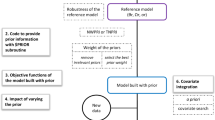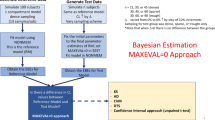Abstract
NONMEM, the only available supported program for population pharmacokinetic analysis, does not provide the analyst with individual subject parameter estimates. As a result, the relationship between pharmacokinetic parameters and demographic factors such as age, gender, and body weight cannot be sought by plotting demographic factors vs. kinetic parameters. To overcome this problem, we devised a three-step approach. In step 1, an initial NONMEM analysis provides the population pharmacokinetic parameters without taking into account the demographic factors. Step 2 consists of individual bayesian regressions using the measured drug concentrations for each subject and the population pharmacokinetic parameters obtained in step 1. The bayesian parameter estimates of the individual subject can be plotted against the demographic factors of interest. From the scatter plots, it can be seen which are the demographic factors that appear to affect the pharmacokinetic parameters. In step 3, the NONMEM analysis is resumed, and the demographic factors found in step 2 are entered into the NONMEM regression model in a stepwise manner. This method was used to analyze the pharmacokinetics of midazolam in 64 subjects from 714 plasma concentrations and 11 demographic factors. CL (elimination clearance) and V1 were found to be a function of body weight. Age and liver disease were found to decrease CL. Of the 11 demographic factors recorded for each patient, none was found to influence Vss or intercompartmental clearance.
Similar content being viewed by others
References
L. B. Sheiner, B. Rosenberg, and V. V. Marathe. Estimation of population characteristics of pharmacokinetic parameters from routine clinical data.J. Pharmacokinet. Biopharm. 5:445–479 (1977).
D. J. Greenblatt, D. R. Abernathy, A. Locniskar, J. S. Harmatz, R. A. Limjuco, and R. I. Shader. Effect of age, gender, and obesity on midazolam kinetics.Anesthesiology 61:27–35 (1984).
P. O. Maitre, B. Funk, C. Crevoisier, and H. R. Ha. Pharmacokinetics of midazolam in patients recovering from cardiac surgery.Eur. J. Clin. Pharmacol. 37:161–166 (1989).
W. D. Owens, J. A. Felts, and E. L. Spitznagel. ASA physical status classification. Anesthesiology.49:239–243 (1978).
S. L. Beal and L. B. Sheiner.NONMEM User's Guide, University of California at San Francisco, San Francisco.
Author information
Authors and Affiliations
Additional information
Supported in part by the Swiss National Science Foundation (Dr. Maitre) and the National Institute on Aging Grant R01-AG03104 (Dr. Stanski). Presented in abstract form at the Annual Meeting of the American Society for Clinical Pharmacology and Therapeutics, Nashville, TN, March 1989.
Rights and permissions
About this article
Cite this article
Maitre, P.O., Bührer, M., Thomson, D. et al. A three-step approach combining bayesian regression and NONMEM population analysis: Application to midazolam. Journal of Pharmacokinetics and Biopharmaceutics 19, 377–384 (1991). https://doi.org/10.1007/BF01061662
Received:
Revised:
Published:
Issue Date:
DOI: https://doi.org/10.1007/BF01061662




